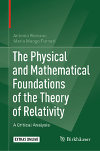- About MAA
- Membership
- MAA Publications
- Periodicals
- Blogs
- MAA Book Series
- MAA Press (an imprint of the AMS)
- MAA Notes
- MAA Reviews
- Mathematical Communication
- Information for Libraries
- Author Resources
- Advertise with MAA
- Meetings
- Competitions
- Programs
- Communities
- MAA Sections
- SIGMAA
- MAA Connect
- Students
- MAA Awards
- Awards Booklets
- Writing Awards
- Teaching Awards
- Service Awards
- Research Awards
- Lecture Awards
- Putnam Competition Individual and Team Winners
- D. E. Shaw Group AMC 8 Awards & Certificates
- Maryam Mirzakhani AMC 10 A Awards & Certificates
- Two Sigma AMC 10 B Awards & Certificates
- Jane Street AMC 12 A Awards & Certificates
- Akamai AMC 12 B Awards & Certificates
- High School Teachers
- News
You are here
The Physical and Mathematical Foundations of the Theory of Relativity

Publisher:
Birkhäuser
Publication Date:
2019
Number of Pages:
496
Format:
Hardcover
Price:
79.99
ISBN:
978-3-030-27236-4
Category:
Textbook
[Reviewed by , on ]
Bill Satzer
04/12/2020
This text on the foundations of general relativity is intended to establish rigorous mathematical foundations and firm connections between mathematical objects and measurable physical quantities. It begins with an extended treatment of the pertinent elements of differential geometry and continues with a review of classical mechanics and electrodynamics. It then treats special relativity in some detail. The book concludes with an extensive treatment of general relativity and cosmology.
Although never explicitly stated by the authors the book appears to have four distinct goals. The first is to introduce students to the special and general theories of relativity. A second is to examine some foundational issues at the interface between mathematics and relativity, and particularly general relativity. The third is to address topics in both special and general relativity that they believe are relevant but often overlooked. The last is to explore more specialized topics in general relativity.
The treatment of differential geometry at the beginning of the book is something between a review and a rapid tutorial. It immediately dives into the details of tensor algebra and moves quickly after that to Riemannian geometry, exterior differentiation and integration, parallel transport and connections.
The topics of classical physics are also handled largely as a review of concepts that the reader is expected to have studied before. The authors emphasize that they want students to understand which classical ideas are abandoned and which retained once they get to relativity theory. The most relevant parts here for the foundational questions are the treatment of reference frames, the differences in dynamics between inertial and non-inertial frames, and the Galilean principle of relativity.
Special relativity prepares the student for the complications of general relativity by introducing some critical concepts in Minkowski space-time where the geometry is simpler. The authors introduce Lorentz transformations and the four-dimensional equations of motion, and here they begin to use the tools of differential geometry with a tensor formulation of electromagnetism in a vacuum and Maxwell’s equations. They also begin to look very carefully at how we can attribute physical significance to some geometrical objects.
The authors’ treatment of the physical foundations of general relativity contends with the problem that there is no general agreement on the formulation of the logical foundations of the theory. They describe heuristic guidelines for formulating a theory under the basic assumption that space-time is a four-dimensional Riemannian manifold with a metric that is related to the matter and energy occupying a region of that manifold. Starting from those reasonable guidelines and assumptions, they describe Einstein’s gravitational field equations that relate the Ricci tensor of space-time geometry to the momentum-energy tensor of the distribution of matter and energy. These amount to a set of ten nonlinear partial differential equations. The authors verify that the equations are hyperbolic, and prove some existence theorems assuming some regularity conditions on space-time. They also describe Einstein’s linearization of these equations, and look at some special solutions of the linearized equations.
The concluding chapters take up specialized topics that include Schwarzschild’s model of space-time and Friedmann’s cosmology. In the final chapter, the authors return to the question of how to relate the physical quantities an observer might measure to the underlying geometry.
It is never clear exactly who the intended readers of this book might be. The authors write sometimes as if the reader were new to the ideas of relativity. In other places, they appear to be addressing experts on subtle issues on the interpretation and application of mathematical concepts to general relativity.
The book is designed as a textbook with a few exercises in the early chapters. As such it would be accessible to graduate students in mathematics and physics who have had more than a minimal exposure to differential geometry and classical physics. Several of the topics throughout the book and particularly in the latter part seem to be directed at experts and more advanced students.
Bill Satzer (bsatzer@gmail.com), now retired from 3M Company, spent most of his career as a mathematician working in industry on a variety of applications ranging from speech recognition and network modeling to optical films and material science. He did his PhD work in dynamical systems and celestial mechanics.
See the publisher's web page.
- Log in to post comments




